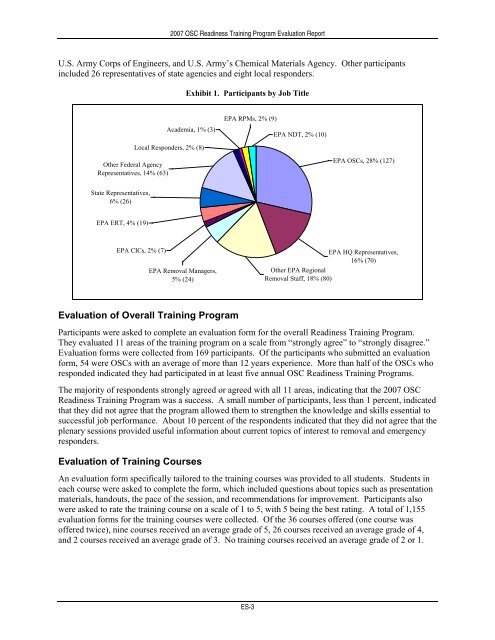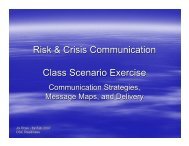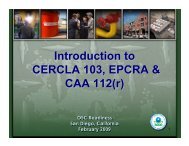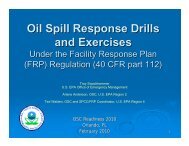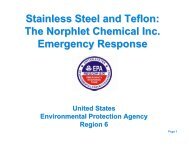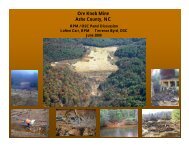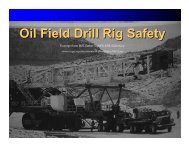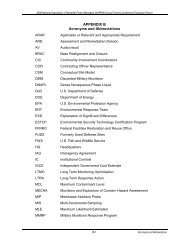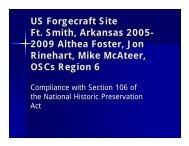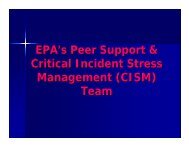OSC 2007 Evaluation Report
OSC 2007 Evaluation Report
OSC 2007 Evaluation Report
You also want an ePaper? Increase the reach of your titles
YUMPU automatically turns print PDFs into web optimized ePapers that Google loves.
<strong>2007</strong> <strong>OSC</strong> Readiness Training Program <strong>Evaluation</strong> <strong>Report</strong><br />
U.S. Army Corps of Engineers, and U.S. Army’s Chemical Materials Agency. Other participants<br />
included 26 representatives of state agencies and eight local responders.<br />
Exhibit 1. Participants by Job Title<br />
EPA RPMs, 2% (9)<br />
Academia, 1% (3)<br />
EPA NDT, 2% (10)<br />
Local Responders, 2% (8)<br />
Other Federal Agency<br />
Representatives, 14% (63)<br />
EPA <strong>OSC</strong>s, 28% (127)<br />
State Representatives,<br />
6% (26)<br />
EPA ERT, 4% (19)<br />
EPA CICs, 2% (7)<br />
EPA Removal Managers,<br />
5% (24)<br />
EPA HQ Representatives,<br />
16% (70)<br />
Other EPA Regional<br />
Removal Staff, 18% (80)<br />
<strong>Evaluation</strong> of Overall Training Program<br />
Participants were asked to complete an evaluation form for the overall Readiness Training Program.<br />
They evaluated 11 areas of the training program on a scale from “strongly agree” to “strongly disagree.”<br />
<strong>Evaluation</strong> forms were collected from 169 participants. Of the participants who submitted an evaluation<br />
form, 54 were <strong>OSC</strong>s with an average of more than 12 years experience. More than half of the <strong>OSC</strong>s who<br />
responded indicated they had participated in at least five annual <strong>OSC</strong> Readiness Training Programs.<br />
The majority of respondents strongly agreed or agreed with all 11 areas, indicating that the <strong>2007</strong> <strong>OSC</strong><br />
Readiness Training Program was a success. A small number of participants, less than 1 percent, indicated<br />
that they did not agree that the program allowed them to strengthen the knowledge and skills essential to<br />
successful job performance. About 10 percent of the respondents indicated that they did not agree that the<br />
plenary sessions provided useful information about current topics of interest to removal and emergency<br />
responders.<br />
<strong>Evaluation</strong> of Training Courses<br />
An evaluation form specifically tailored to the training courses was provided to all students. Students in<br />
each course were asked to complete the form, which included questions about topics such as presentation<br />
materials, handouts, the pace of the session, and recommendations for improvement. Participants also<br />
were asked to rate the training course on a scale of 1 to 5, with 5 being the best rating. A total of 1,155<br />
evaluation forms for the training courses were collected. Of the 36 courses offered (one course was<br />
offered twice), nine courses received an average grade of 5, 26 courses received an average grade of 4,<br />
and 2 courses received an average grade of 3. No training courses received an average grade of 2 or 1.<br />
ES-3


